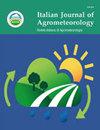Technical and economic study of irrigation scheduling devices on corn water productivity in a semi-arid region
IF 0.8
4区 农林科学
Q2 AGRONOMY
Italian Journal of Agrometeorology-Rivista Italiana Di Agrometeorologia
Pub Date : 2022-07-19
DOI:10.36253/ijam-1513
引用次数: 1
Abstract
It is essential to consider water allocation control and on-farm irrigation scheduling to increase water productivity in agriculture. There are several devices used for irrigation scheduling, however the best device with the most priority is not identified yet. In the present study, the effect of using several irrigation scheduling devices on increasing water productivity in a corn field was investigated. The devices were classified technically and economically using analytic hierarchy process. The experimental farm was located in a semi-arid region in Iran, which was managed by a farmer and irrigated with drip irrigation system. Six techniques for irrigation scheduling were studied including Penman-Monteith model (T2), infrared thermometer (T3), soil moisture meter (T4), tensiometer (T5), and gypsum block (T6). The irrigation scheduling treatments were compared with the conventional treatment adopted by the farmer (T1). Economic analysis was performed. The ease of use of the devices was also evaluated. Results showed for the irrigation scheduling treatments of T3 to T6, applied irrigation water was reduced by 11 to 26% compared to T1. The corn yield in irrigation scheduling treatments was not reduced significantly compared to T1. As a result, water productivity increased by 35% from 2.0 to 2.7 kg/m3. The best irrigation scheduling device in terms of water productivity was gypsum block. In regard to affordability and ease of use by farmers, the Penman-Monteith model had more priority. Considering all assessment criteria, tensiometer (T5) was given the first priority. The infrared thermometer (T3) and Penman-Monteith model (T2) were identified as the next priorities.半干旱地区灌溉调度装置对玉米水分生产率的技术经济研究
要提高农业水分生产力,必须考虑水分分配控制和农田灌溉调度。有几种设备用于灌溉调度,但最优先级的最佳设备尚未确定。研究了不同灌溉调度方式对提高玉米田水分生产力的影响。采用层次分析法对设备进行了技术经济分类。该试验农场位于伊朗半干旱地区,由一名农民管理,采用滴灌系统灌溉。研究了Penman-Monteith模型(T2)、红外测温仪(T3)、土壤水分计(T4)、张力计(T5)和石膏块(T6)等6种灌溉调度技术。将灌溉调度处理与农户采用的常规处理(T1)进行比较。进行了经济分析。还对设备的易用性进行了评价。结果表明:T3 ~ T6灌溉调度处理的灌溉水用量较T1减少11% ~ 26%;与T1相比,灌溉调度处理的玉米产量没有显著降低。结果,水生产力从2.0 kg/m3提高到2.7 kg/m3,提高了35%。从水分生产力的角度来看,石膏块是最佳的灌溉调度装置。考虑到农民的可负担性和易用性,Penman-Monteith模型更受重视。综合所有评价标准,拉力仪(T5)被优先考虑。红外测温仪(T3)和Penman-Monteith模型(T2)被确定为下一步的重点。
本文章由计算机程序翻译,如有差异,请以英文原文为准。
求助全文
约1分钟内获得全文
求助全文
来源期刊

Italian Journal of Agrometeorology-Rivista Italiana Di Agrometeorologia
AGRONOMY-ENVIRONMENTAL SCIENCES
CiteScore
2.10
自引率
8.30%
发文量
6
期刊介绍:
Among the areas of specific interest of the journal there are: ecophysiology; phenology; plant growth, quality and quantity of production; plant pathology; entomology; welfare conditions of livestocks; soil physics and hydrology; micrometeorology; modeling, simulation and forecasting; remote sensing; territorial planning; geographical information systems and spatialization techniques; instrumentation to measure physical and biological quantities; data validation techniques, agroclimatology; agriculture scientific dissemination; support services for farmers.
 求助内容:
求助内容: 应助结果提醒方式:
应助结果提醒方式:


